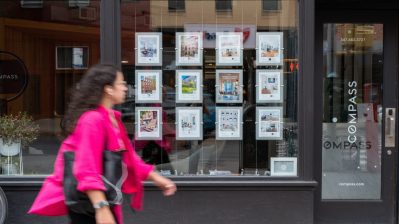Secrets of the Christmas tree lot
Americans bought 33 million Christmas trees last year by one count, making it a billion-dollar industry in this country alone. Perhaps nowhere are Christmas tree sales more visible than on the streets of New York City.
Supriya and Vijay Laknidhi walk through a narrow evergreen forest on a sidewalk in Brooklyn Heights. They stop in front of a 7-foot Fraser fir.
“It’s pretty full, you know so even if you don’t have that many ornaments on there it still looks like a really healthy tree,” Supriya says. Vijay adds, “we just had our first kid, so it’s a tree with an occasion now.
The Laknidhis are purchasing their family’s tree from another family tree. Ellie Bishop’s family started selling trees in 1988 when she was little more than a year old. Now, she has her baby at the stand, alongside her mother and brother. These three generations of tree sellers manage a stable in Vermont the rest of the year. But that’s not necessarily where the trees come from.
“Well it kinda works like this: A bunch of tree sellers all throughout the city get together. We buy from big tree farms in different parts of the country,” Bishop says. “These ones come from North Carolina, sometimes [they come] all the way from Oregon. It just depends where they’re ordered from, where we get the best deal.”
Bishop’s supplier buys evergreens from wherever the trees grow the fastest. The vendors come from wherever work during the winter is slow.
“Selling trees really helps people get through January, February till they can get back to work in March,” Bishop says.
Last year Ellie’s family sold about 300 trees, mostly priced between $55 and $140. It’s not easy work staying out on the street, in freezing temperatures, all day for most of December. Still, it’s enough to lure seasonal workers like Melany Westerloppe, who’s from Quebec. She runs a stand in the Chelsea neighborhood of Manhattan. High end trees here go for $400 – last year she sold to Robert De Niro. It’s the adventure as well as the money that lures hundreds of French-Canadians like her to the city.
Westerloppe estimates, “our company it’s about 300 stands in all the city because we are two or three people by stand.”
The company, Forever Evergreen, is incorporated in Florida. It supplies to every stand I came across and owns hundreds of its own. The company is secretive, running a cash business that’s largely unregulated – and staffed by a migrant work force.
Simon Durind also sells trees in Manhattan. I asked him why a Florida-based company, buying trees from North Carolina, wants French Canadians to sell Christmas trees in New York City?
“They like Quebecois with an accent on the streets selling trees, looking like a North Viking. That’s what they like and it works,” exclaims Durind, a carpenter in Quebec who says he doesn’t mind living out of a van for a month. He estimates he makes $17 an hour for the season. But there are other perks for these French-speaking, pine-scented gentlemen.
“The women of New York are very beautiful,” Durind says. “You know you don’t often see people like us, cutting trees with a saw and sometimes it looks like it impresses some people.”
Mistletoe sold separately.
There’s a lot happening in the world. Through it all, Marketplace is here for you.
You rely on Marketplace to break down the world’s events and tell you how it affects you in a fact-based, approachable way. We rely on your financial support to keep making that possible.
Your donation today powers the independent journalism that you rely on. For just $5/month, you can help sustain Marketplace so we can keep reporting on the things that matter to you.


















